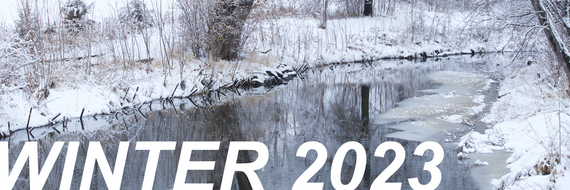 Welcome to the Winter 2023 edition of the Water Resources Update. This semiannual newsletter is sent to collaborators of the Metropolitan Council Environmental Services Water Resources group, including water resource professionals in the Twin Cities region and our stream and lake monitoring partners. The Water Resources group works to build strong partnerships dedicated to ensuring clean, healthy, and abundant water resources in the Twin Cities metropolitan area.
 Striving toward more integrated water planning
A year ago, our Water Supply Planning and Water Resources groups merged into one. This has created more opportunities for wholistic approaches to water planning for the region. Over the past several months, we have continued making progress merging the work of the formerly separate groups.
Several new staff have recently been hired to support the additional water planning efforts. Greg Johnson, principal engineer, leads the Technical Advisory Committee for the Metro Area Water Supply Advisory Committee work and provides technical guidance on water utility planning projects. Jen Kader, senior planner, leads our subregional engagements and helps build relationships with our stakeholders in the watershed, water utility, and regional planning areas. Steve Christopher, environmental analyst, co-leads the Water Advisory Group and supports policy development and engagement for the Water Policy Plan. Additionally, Jennifer (Jen) Kostrzewski was promoted to a newly created assistant manager position, focused specifically on water planning and policy work.
 From left to right: Greg Johnson, Jen Kader, Steve Christopher, Jen Kostrzewski
We also plan to enhance support for water planning in the region by taking advantage of new connections between monitoring, assessment, planning, and policy after merging the groups. These connections will allow us to improve the support we offer by implementing a continuous loop of planning water policies based on data and assessment, implementing those policies, checking their performance, and then adjusting or improving the policies based on the outcome.
Monitoring challenges due to drought
Dry conditions in the region created unique challenges for water monitoring this past summer. Some lake monitoring volunteers were forced to stop monitoring because they could not safely access the lake due to low water levels caused by the drought. Monitoring equipment had to be modified in some streams to ensure they stayed underwater in the low-flow conditions. At some locations, the way a sample was collected had to be changed to avoid disturbing the bottom sediment because the water levels were so low.
Despite these challenges, we were able to collect another year of data, which is publicly available to download from our Environmental Information Management System (EIMS) data portal. Preliminary data are available to download from the portal, and new results are processed daily. Some data are reviewed and finalized throughout the year, and all 2023 data will be finalized around February 2024.
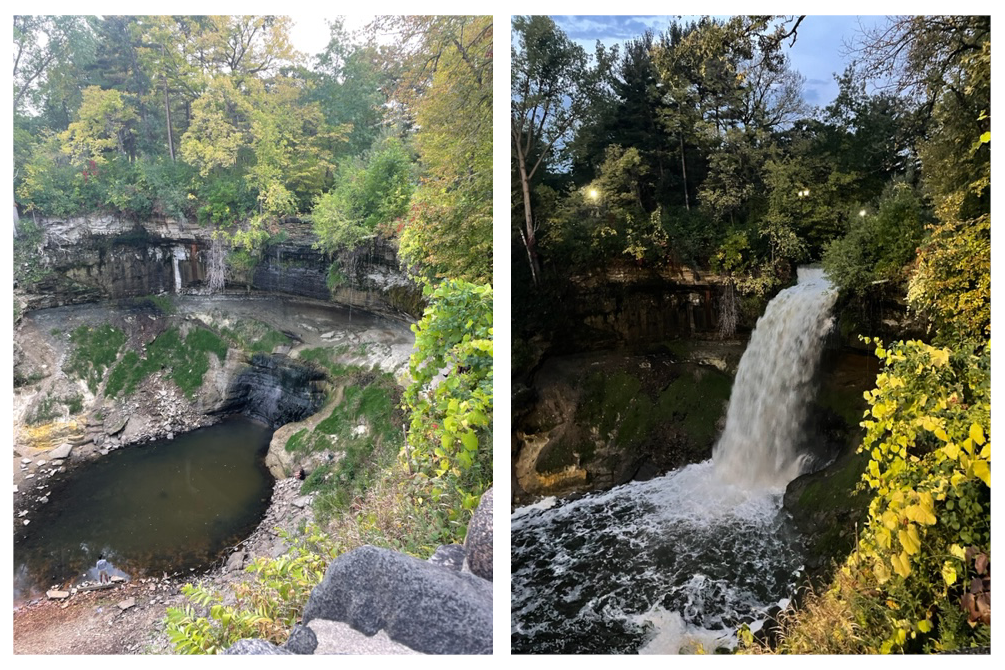 Minnehaha Falls on Sept. 21 during dry conditions (left) compared to Sept. 29 after 6+ inches of rain in a week (right). Photo credit: Kelsey Hogan
 Stream and river biomonitoring
The types of organisms that live in the water can tell us a lot about the quality of the environment. We recently wrapped up 2023 biological sampling at our river and stream monitoring sites. The river biomonitoring effort consists of eight sites on the Minnesota and Mississippi rivers. For the first time since river biomonitoring was resumed in 2017, we were able to collect the biological monitoring equipment from all eight sites, which is an achievement since most years at least one or two go missing due to storms or tampering from curious boaters. Similarly, we were able to collect biological samples at 18 of our stream monitoring sites.
The samples from this year are still being processed, and the results will be available in 2024. We expect to find that the dry conditions this summer affected the biological communities in our rivers and streams. For example, when flows are low, there is less habitat available for bugs and fish since the water doesn’t fill the channel to reach important habitat sites like undercut banks or overhanging vegetation.
If you are interested in accessing our river and stream biological data, please reach out to Jennifer Keville at jennifer.keville@metc.state.mn.us. We have macroinvertebrate data for many streams in the region beginning in the 2000s. For the Minnesota and Mississippi rivers, macroinvertebrate data are available from 1973-2003, 2007-2009, and 2017 to present.
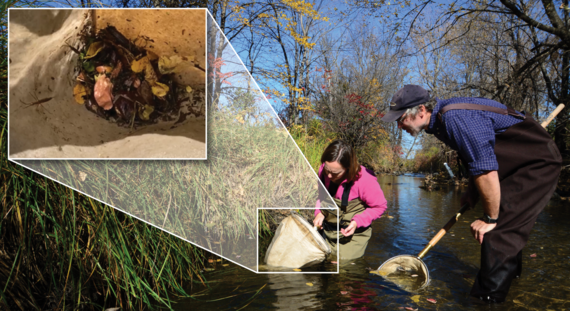 Scientists Cassie Champion and Scott Haire collecting biological samples in Credit River (main photo); a view inside the sampling nets, showing some water scorpions among the leaf litter (inset)
 New continuous monitoring equipment in Mississippi River Pool 2


We are in the process of upgrading our continuous monitoring equipment on Pool 2 of the Mississippi River. The previous system worked by pumping water to shelters on the riverbank, which housed the equipment to take water quality measurements. This setup required frequent cleaning and recalibration to keep running.
To replace the previous system (shown in the upper right image), we have deployed In-Situ sondes and telemetry devices at three locations. The sondes are installed in pipes that are submerged directly into the river (shown in the lower right image), where they continuously measure temperature, depth, specific conductivity, turbidity, and dissolved oxygen. This setup eliminates the need for shelters on the shoreline and will reduce equipment maintenance time.
The past summer, the previous system with the shelters and the new setup using In-Situ sondes were run in parallel at all three sites. After confirming the quality of the data collected from the In-Situ sondes, we will start to decommission the shelters, likely in the spring of 2024, and begin to implement the In-Situ sondes at additional river sites as well.
Preliminary continuous monitoring data from the most recent six months are available to download from our EIMS data portal. Please contact Jennifer Keville at jennifer.keville@metc.state.mn.us to request the reviewed historical dataset.
|
Planning toward 2050
Our staff are continuing their work to update the Water Policy Plan, with the goal of the Met Council approving the plan by early 2025 as part of the overall Regional Development Guide adoption. Since the beginning of the plan update process, we have been working with stakeholders and advisory groups to ensure that the policies put forward help the region work toward sustainable waters and are responsive to current and future challenges.
Over the past two years, our staff and others in Environmental Services have been writing research papers that investigate current and future water concerns and offer recommendations for the metro region. Five of the seven research papers have been completed and are available on our Water Policy Plan Research website. The development of these papers has been an important step in this planning cycle, creating another opportunity to engage with stakeholders and provide insight to the Water Policy Plan authoring team as they begin to write policy. Engagement with our Council members, partner organizations, and residents will continue as policy is drafted, revised, and finalized.
To stay up to date with the planning process and learn about opportunities to provide input, visit the 2050 Water Policy Plan Update webpage.
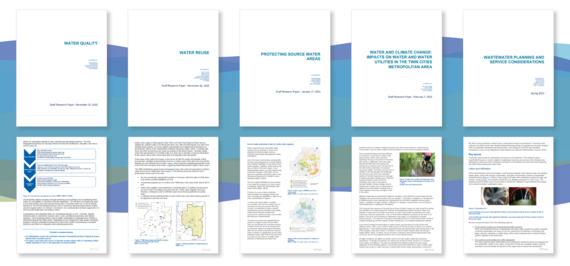 Research papers available for reading and download online
 Convening to create solutions for White Bear Lake
This spring, the Minnesota Legislature recognized the vital role the Met Council plays as a convener in the region. They tasked us to lead a work group of representatives from 14 communities in the White Bear Lake area to explore ways to ensure access to sustainable surface and groundwater resources. These communities are faced with balancing a myriad of water challenges including PFAS contamination, litigation surrounding lake levels in White Bear Lake, and questions of how best to ensure adequate and equitable water supply for existing populations and growing communities going forward. The work group must report back to the legislature in 2027 with a comprehensive plan to supply the water needs in the area for future generations.
For more information, visit the White Bear Lake Area Comprehensive Plan Work Group website. Notes and materials will be posted there as the work kicks off in early 2024.
Award-winning Water Efficiency Grant Program to continue in 2024-2026
Earlier this year, the Minnesota Legislature allocated $1.5 million in Clean Water, Land and Legacy funds to the Met Council to assist municipalities in the metro region with implementing water demand reduction. This funding allows us to continue offering the Water Efficiency Grant Program for another two-year grant cycle. Cities and townships served by a municipal water supply system apply for awards to help residents upgrade to water-efficient devices. Municipalities can use the grant to reduce purchase costs for residents, commercial properties, and government facilities that upgrade to water-efficient toilets, washing machines, dishwashers, irrigation systems, and more.
A call for applications for the next grant cycle will go out in early 2024, with the start of the program planned for July 2024. To learn more about the program and keep up to date with the application process, visit the Water Efficiency Grant Program webpage.
Each year, the Environmental Protection Agency’s WaterSense program awards partner organizations for their efforts in supporting the program. On October 5th, WaterSense recognized the Met Council with a 2023 award for Excellence in Promoting WaterSense. This award celebrates our water efficiency work in 2022 – in particular, the replacement of more than 2,000 water-using devices with WaterSense labeled alternatives through the Water Efficiency Grant Program.
To learn more about WaterSense and the 2023 award-winners, visit the WaterSense website.
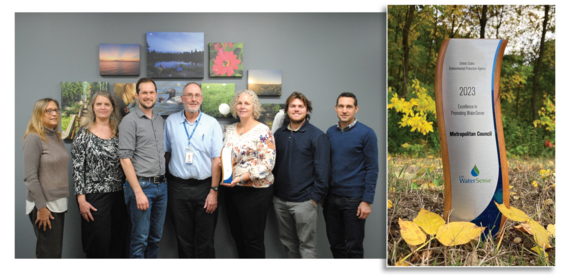 Water Resources staff with the WaterSense Award (left) and close-up of the WaterSense Award (right)
 MnTAP – Met Council partnership: Interns, industry, improved efficiency
The Minnesota Technical Assistance Program (MnTAP) is currently accepting project proposals for the 2024 summer intern program. MnTAP is an outreach program within the University of Minnesota School of Public Health which helps Minnesota businesses develop and implement industry-tailored solutions that prevent pollution at the source, maximize efficient use of resources, and reduce energy use and costs to improve public health and the environment. This program has impressive results with cumulative annual savings of 146 million gallons of water and $1.5 million dollars.
Our partnership with MnTAP began in 2012, and since then we have provided full or partial support for more than 40 MnTAP-facilitated intern projects with an emphasis on water efficiency and conservation. For more information, visit the MnTAP intern website.
If your organization is interested in hosting an intern next summer, proposals can be submitted on the Intern Project Proposal webpage. Project proposals must include information about waste generation or energy use, a project description and goals, staff contacts, and your organization’s ability to contribute a cost-share.
  
Judy Sventek
Manager
Water Resources
Send an email
651-602-1156 Office
612-723-4599 Cell

Dan Henely
Assistant Manager
Monitoring and Assessment
Send an email
651-602-8085 Office
651-491-4304 Cell

Jen Kostrzewski
Assistant Manager
Policy and Planning
Send an email
651-602-1078 Office
  
|